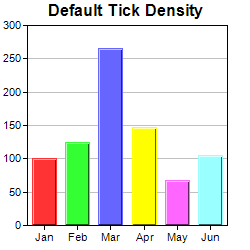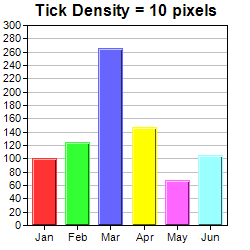

This example demonstrates how to control the axis tick density in auto-scaling.
By default, in auto-scaling, ChartDirector automatically chooses the tick spacing for the axis.
In some cases, you may want to suggest the tick spacing to use. This can be done by using Axis.setTickDensity.
Note that the actual tick spacing chosen by ChartDirector may not be equal to the suggested tick spacing. The suggested tick spacing is only a lower bound. It is because there may be other constraints when choosing the ticks. For example, the tick positions should be "neat numbers", such as (0, 5, 10, ...), and not arbitrary numbers like (0, 4.792, 9.584, ...). Also, by default, the axis starts and ends at tick positions (configurable using Axis.setRounding), which means the axis length must be divisible by the tick spacing. These and other constraints will affect the exact ticks being chosen.
In this example, one of the charts is drawn using the default tick spacing. The other chart is drawn using a suggested tick spacing of 10 pixels. Note that the actual tick spacing is slightly larger than 10 pixels.